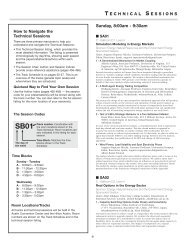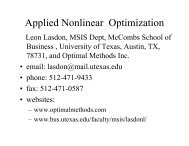Sunday
Sunday
Sunday
Create successful ePaper yourself
Turn your PDF publications into a flip-book with our unique Google optimized e-Paper software.
SB19<br />
■ SB19<br />
19- West 211 A- CC<br />
Joint Session Healthcare Logistics/SPPSN: Routing<br />
Problems in Healthcare Operations I<br />
Cluster: Healthcare Logistics & Public Programs, Service and Needs<br />
Invited Session<br />
Chair: Burcu Keskin, University of Alabama, Alston Hall, Box: 870226,<br />
Tuscaloosa, AL, 3587-0226, United States of America,<br />
bkeskin@cba.ua.edu<br />
1 - A Sequential GRASP for the Therapist Routing and<br />
Scheduling Problem<br />
Yufen Shao, Research Engineer, ExxonMobil Upstream Research<br />
Company, 3120 Buffalo Speedway, Houston, TX, 77098, United<br />
States of America, yufen.shao@exxonmobil.com, Ahmad Jarrah,<br />
Jonathan Bard<br />
This talk presents a sequential GRASP for solving a weekly routing and<br />
scheduling problem for therapists. The problem contains both fixed and flexible<br />
patients with respect to appointment times, and two grades of therapists. In Phase<br />
I, feasible solutions are constructed one therapist and one day at a time. In Phase<br />
II, a high-level neighborhood search is proposed to obtain local optima.<br />
Performance is demonstrated using real and randomly generated data sets.<br />
2 - An Optimisation Model for Staff Planning in a<br />
Home Care Organization<br />
Pablo Andres Maya Duque, PhD, University of Antwerp/<br />
Universidad de Antioquia, Ottoveniusstrat 26, box 6, Antwerp,<br />
2000, Belgium, pmayaduque@gmail.com, Peter Goos,<br />
Kenneth Sörensen, Marco Castro<br />
In this talk, we present the core optimization component of a decision support<br />
system that Landelijke Thuiszorg, a non-profit organization that provides home<br />
care services for several provinces in Belgium, will implement in order to assist<br />
the regional service planning. The optimization model takes into account<br />
assignment, scheduling and routing decisions simultaneously, while considering<br />
two objectives, namely the service level and the travelled distance.<br />
3 - Incorporating Patient, Nurse, and Agency Considerations in<br />
Home Health Care Routing<br />
Ashlea Bennett Milburn, Assistant Professor, University of<br />
Arkansas, 4207 Bell Engineering Center, Fayetteville, AR,<br />
United States of America, ashlea@uark.edu, Jessica Spicer<br />
Home health routing and scheduling problems can be modeled as multi-objective<br />
optimization problems, as home health agencies are often interested in creating<br />
nurse routes that achieve a variety of goals. We use a multi-objective tabu search<br />
heuristic to study the relationship among travel cost, nurse consistency (a<br />
measure of patient satisfaction), and balanced workload (an indicator of nurse<br />
satisfaction) objectives. Computational results for a number of realistic scenarios<br />
are presented.<br />
4 - A Multi-period Home Care Scheduling Problem with<br />
Work Balance<br />
Burcu Keskin, University of Alabama, Alston Hall, Box: 870226,<br />
Tuscaloosa, AL, 3587-0226, United States of America,<br />
bkeskin@cba.ua.edu, Shirley (Rong) Li, Charles Schmidt<br />
We consider a home health care scheduling problem for a local hospital with<br />
multiple types of caregivers. We determine the assignment of caregivers to the<br />
patients visited at their homes so that the total routing costs are minimized and<br />
the workload of caregivers are balanced over a planning horizon while satisfying<br />
synchronization, precedence, loyalty, and other practical constraints. We present a<br />
MILP formulation and a branch-and-price solution approach based on Dantzig-<br />
Wolfe decomposition.<br />
■ SB20<br />
20- West 211B- CC<br />
Software Demonstration<br />
Invited Session<br />
1 - American Optimal Decisions - Portfolio Safeguard (PSG):<br />
Advanced Nonlinear Mixed-Integer Optimization Package<br />
Stan Uryasev,American Optimal Decisions, 5214 SW 91 Way, Ste.<br />
#130, Gainesville FL 32608, United States of America,<br />
uryasev@aorda.com<br />
Portfolio Safeguard is an advanced nonlinear mixed-integer optimization package<br />
used in risk management, financial engineering, military, medical and other<br />
applications. Design and solve complex optimization problems with built-in<br />
functions (maximum, StDev, variance, probability, VaR, CVaR, cardinality, fixedcharge,<br />
recourse etc.). See real-life case studies in Windows and MATLAB at<br />
www.aorda.com/aod/psg.action.<br />
INFORMS Phoenix – 2012<br />
86<br />
■ SB21<br />
21- West 212 A- CC<br />
Advances in Networks and Graphs<br />
Contributed Session<br />
Chair: Sivan Altinakar, École Polytechnique de Montréal, C.P. 6079,<br />
Succ. Centre-ville, Montreal, QC, H3C 3A7, Canada,<br />
sivan.altinakar@gerad.ca<br />
1 - Approximating Precedence Network Structure with<br />
Incomplete Information<br />
Adam Graunke, The Boeing Company, P.O. Box 3707, MC 13-98,<br />
Seattle, WA, 98124, United States of America,<br />
adam.a.graunke@boeing.com, Gabriel Burnett<br />
Accurate precedence networks are highly useful for planning and analysis, yet in<br />
large scale production systems, they are difficult, if not impossible, to define. In<br />
this research we investigate precedence networks in the presence of incomplete<br />
precedence information, with the goal of estimating production-critical properties<br />
of the network. Specifically, we investigate critical path analyses and the level of<br />
confidence associated with the results.<br />
2 - Shortest Path with Secure Multipary Computation<br />
Abdelrahaman Aly, Universite Catholique de Louvain, 34,<br />
Voie du Roman Pays, Louvain-la-Neuve, 1348, Belgium,<br />
abdelrahaman.aly@uclouvain.be, Mathieu Van Vyve<br />
In various applications, i.e. elections, auctions, the computation of a global<br />
optimum requires input data from competing parties. A trusted third party to<br />
perform these computations is not guaranteed. Secure Multiparty Computation<br />
(SMC) is an encryption method which does not rely on such third party. The<br />
present research expands SMC’s scenario to Shortest Path problem. We describe<br />
SMC variants of Bellman-Ford and Dijkstra algorithms and compare their<br />
performance with the traditional variants.<br />
3 - Reconstruction of Three Dimensional Objects from Three<br />
Orthogonal Cartesian Bi-plane Projections<br />
Siddhartha Sampath, Arizona State University,<br />
849 W Elna Rae, Tempe, AZ, United States of America,<br />
Siddhartha.Sampath@asu.edu, Pavithra Ramamoorthy,<br />
Pitu Mirchandani<br />
This application describes a network flow model for reconstructing the threedimensional<br />
shape of a three dimensional object from biplane x-ray readings for<br />
all three orthogonal Cartesian planes.Each two-dimensional cross-section consists<br />
of one region or view of the object whose image is to be reconstructed.We can use<br />
apriori information to constrain the number of solutions, and then to obtain most<br />
likely reconstruction.<br />
4 - Breaking Symmetry in Consecutive Edge-coloring<br />
Sivan Altinakar, École Polytechnique de Montreal, C.P. 6079,<br />
Succ. Centre-ville, Montreal, QC, H3C 3A7, Canada,<br />
sivan.altinakar@gerad.ca, Alain Hertz, Gilles Caporossi<br />
Consecutive edge-coloring, a special case of edge-coloring in graph theory, aims to<br />
minimize the sum of the span of colors (integers) incident to each node. This has<br />
applications in scheduling. It is also NP-hard, and may be difficult to solve exactly<br />
even for a very small number of vertices. We compare different modeling<br />
approaches in Mixed Integer Programming and Constraint Programming, with an<br />
emphasis on the latter, and subsets of Lex-Leader constraints for efficient<br />
symmetry breaking.<br />
■ SB22<br />
22- West 212 B- CC<br />
COIN-OR Multi-Threading Software<br />
Sponsor: Computing Society<br />
Sponsored Session<br />
Chair: Bradley Bell, Senior Research Scientist/Enginer, University of<br />
Washington, IHME, 2301 Fifth Ave., Suite 600, Seattle, WA, 98121,<br />
United States of America, bradbell@seanet.com<br />
1 - Could We Use a Million Cores to Solve a Single Integer<br />
Program?<br />
Ted Ralphs, Associate Professor, Lehigh University, 200 West<br />
Packer Avenue, Bethlehem, PA, 18015, United States of America,<br />
ted@lehigh.edu, Thorsten Koch, Yuji Shinano<br />
Given the steady increase in cores per CPU, it is only a matter of time before<br />
supercomputers will have a million or more cores. In this talk, we investigate the<br />
opportunities and challenges that will arise when trying to utilize the distributed<br />
multi-core architectures that have recently become pervasive to solve a single<br />
integer linear optimization problem. We raise the question whether best practices<br />
in sequential solution of ILPs will be effective in massively parallel environments.



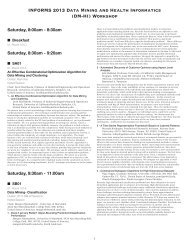
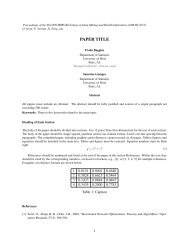
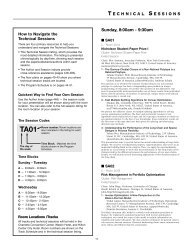
![[PDF] Charlotte Back Matter](https://img.yumpu.com/17933057/1/190x245/pdf-charlotte-back-matter.jpg?quality=85)

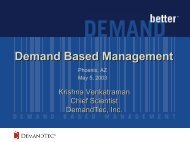
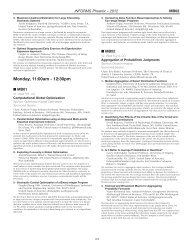
![[PDF] ALIO Back Matter](https://img.yumpu.com/17932960/1/190x245/pdf-alio-back-matter.jpg?quality=85)

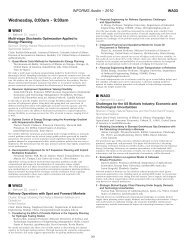
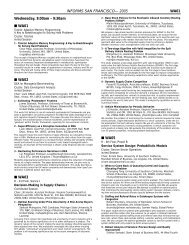
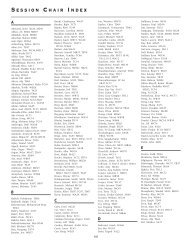
![[PDF] Monday, 8:00am - 9:30am](https://img.yumpu.com/17932954/1/190x245/pdf-monday-800am-930am.jpg?quality=85)
